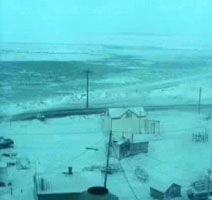
Utqiaġvik Sea Ice Webcam - Live video footage of the ocean and sea ice conditions as seen looking north from atop the bank building in downtown Utqiaġvik, Alaska (formerly known as Barrow), and archived time-lapse videos (one image per day) of the annual sea ice cycle from the 2000 to 2010 sea ice seasons (early footage is from a webcam mounted at NARL, north of town). Webcam operated by the Sea Ice Group at the Geophysical Institute, University of Alaska Fairbanks. For more information, contact: icecam@gi.alaska.edu.
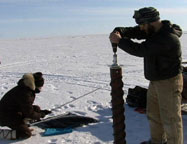
Video of sea ice research being conducted by Dr. Andrew Mahoney, Professor of Geophysics, Geophysical Institute, University of Alaska Fairbanks with assistance from graduate student, Rebecca Rolph, on the ice of Kotzebue Sound out from Kotzebue and Sisualik on March 28, 2016. Cyrus Harris guided the group and discusses the ice conditions, a seal breathing hole they come upon, and his observations about changing ice conditions in the region. Videographer was Karen Brewster, Research Associate, Oral History Program, University of Alaska Fairbanks. (ORAL HISTORY 2013-25-31; 25:56 min.)
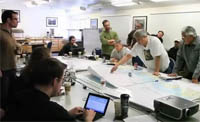
Video from Experts Workshop to Comparatively Evaluate Coastal Currents and Ice Movement in the Northeastern Chukchi Sea, Barrow and Wainwright, Alaska, March 11-15, 2013. A group of Iñupiaq ice and ocean experts met with oceanographers, geophysicists and geospatial information specialists to talk about their knowledge of ocean and currents and ice conditions in northern Alaska. Video by Nokinba Acker. (Written report about the workshop: Johnson, M.A., H. Eicken, M. L. Druckenmiller and R. Glenn, Editors (2014): Experts Workshops to Comparatively Evaluate Coastal Currents and Ice Movement in the Northeastern Chukchi Sea; Barrow and Wainwright, Alaska, March 11-15, 2013. University of Alaska Fairbanks, Fairbanks, Alaska.) (11:04 min.)
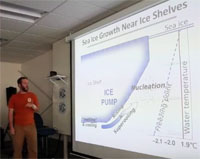
Video of Dr. Andrew Mahoney, Professor of Geophysics, Geophysical Institute, University of Alaska Fairbanks, giving a Barrow Arctic Science Consortium "Saturday Talk" titled Sea Ice and Its Global Importance on August 6, 2011 in Utqiaġvik, Alaska (previously known as Barrow). Video produced by Nokinba Acker of the Barrow Arctic Science Consortium. (26:49 min.)
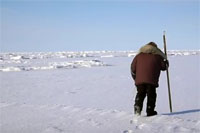
Sea Ice Secure, episode of the film series Tied to the Land: Voices From Northwest Alaska filmed and edited by Sarah Betcher, 2015. This video showcases ways in which local people are seeking adaptive ways to go about their subsistence way of life in the wake of rapid change in sea ice conditions. It is part of a series titled Sustainable Futures North that was supported by a grant from the National Science Foundation Arctic Science, Education, and Engineering for Sustainability program (Arctic SEES). (10:14 min.) For other films by Sarah Betcher about Native cultures, subsistence, climate change, and adaptation in Alaska, see the website for her company, Farthest North Films.
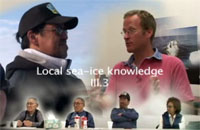
Video of elders talking about sea ice in Utqiaġvik, Alaska (previously known as Barrow) in 2008, Part 1 of 2. Excerpt from Dr. Hajo Eicken’s Sea Ice Field Course in Barrow, Alaska titled: "Field Techniques for Sea Ice Research International Polar Year 2007-2009.” Recorded by Maya Salganek. Speakers include Warren Matumeak, Wesley Aiken, Joe Leavitt and Nancy Leavitt. The video also includes shots out on the ice while talking about conditions, and researcher, Henry Huntington, explaining the project. (6:57 min.)
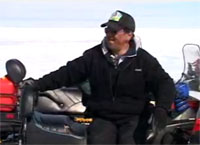
Video of elders talking about sea ice in Utqiaġvik, Alaska (previously known as Barrow) in 2008, Part 2 of 2. Excerpt from Dr. Hajo Eicken’s Sea Ice Field Course in Barrow, Alaska titled: "Field Techniques for Sea Ice Research International Polar Year 2007-2009.” Recorded by Maya Salganek. Speakers include Warren Matumeak, Joe Leavitt, and Wesley Aiken. The video also includes shots out on the ice while talking about conditions, and researcher, Henry Huntington, explaining the project. (6:09 min.)
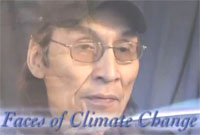
Faces of Climate Change: Introduction is the first of a three-part series of short videos showcasing the dramatic changes in Alaska's marine ecosystems through interviews with scientists and Alaska Natives. This episode provides an introductory overview of climate change impacts on the people, culture and environment in Alaska. The videos were produced in 2011 by Alaska Sea Grant in partnership with Alaska Ocean Observing System, Alaska Marine Conservation Council, and COSEE Alaska. (5:54 min.)

Faces of Climate Change: Disappearing Sea Ice is the second of a three-part series of short videos showcasing the dramatic changes in Alaska's marine ecosystems through interviews with scientists and Alaska Natives. This episode highlights the Arctic's disappearing sea ice. The videos were produced in 2011 by Alaska Sea Grant in partnership with Alaska Ocean Observing System, Alaska Marine Conservation Council, and COSEE Alaska. (10:45 min.)
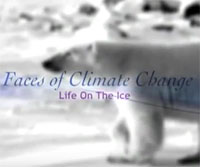
Faces of Climate Change: Life on the Ice is the third of a three-part series of short videos showcasing the dramatic changes in Alaska's marine ecosystems through interviews with scientists and Alaska Natives. This episode highlights Arctic marine mammals and birds and how they depend on sea ice, and how these animals will cope in the face of climate change. The videos were produced in 2011 by Alaska Sea Grant in partnership with Alaska Ocean Observing System, Alaska Marine Conservation Council, and COSEE Alaska. (7:33 min.)
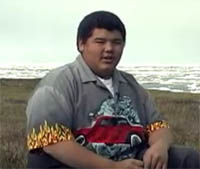
Video of Iñupiaq people in Utqiaġvik, Alaska (previously known as Barrow) talking about their observations of changes in the sea ice and broader environment and how these changes are affecting their lives, and scientists who study climate change talking about their research and observations. Video by the Education through Cultural and Historical Organizations Program (ECHO) partners - New Bedford Whaling Museum, North Slope Borough, Alaska Heritage Center, Bishop Museum, and Peabody Essex Museum, 2009. (4:34 min.)
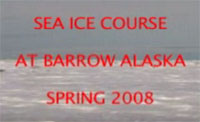
Video of ice core sampling methodology as taught by Dr. Hajo Eicken of the Geophysical Institute, University of Alaska Fairbanks in his 2008 Sea Ice Field Course in Barrow, Alaska titled: "Field Techniques for Sea Ice Research International Polar Year 2007-2009,” Part 1 of 2. Recorded by Maya Salganek. (7:08 min.)
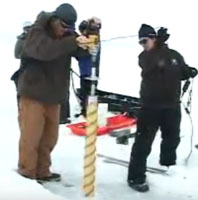
Video of ice core sampling methodology as taught by Dr. Hajo Eicken of the Geophysical Institute, University of Alaska Fairbanks in his 2008 Sea Ice Field Course in Barrow, Alaska titled: "Field Techniques for Sea Ice Research International Polar Year 2007-2009,” Part 2 of 2. Recorded by Maya Salganek. (6:45 min.)
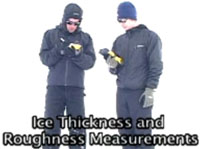
Video of measuring ice thickness methodology as taught by Professor Christian Haas, a sea ice physicist from the University of Alberta, as part of the 2008 Sea Ice Field Course in Barrow, Alaska titled: "Field Techniques for Sea Ice Research International Polar Year 2007-2009.” Recorded by Maya Salganek. (7:53 min.)

Video of measuring temperature, salinity, and current variations created from ice/ocean interaction as taught by Dr. Kunio Shirasawa of Hokkaido University, as part of the 2008 Sea Ice Field Course in Barrow, Alaska titled: "Field Techniques for Sea Ice Research International Polar Year 2007-2009.” Recorded by Maya Salganek. (3:13 min.)
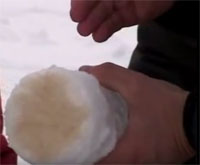
Video of biochemistry research of sea ice as taught by Rolf Gradinger of the Insitute of Marine Sciences, University of Alaska Fairbanks as part of the 2008 Sea Ice Field Course in Barrow, Alaska titled: "Field Techniques for Sea Ice Research International Polar Year 2007-2009.” Recorded by Maya Salganek. (8:27 min.)

The Visual History of Sea Ice: Archival vs. Modern Film Footage is a video by Samuel K. German that he produced for an undergraduate video project at the University of Alaska Fairbanks in 2008. The project was funded by the National Science Foundation's EPSCor (Established Program to Stimulate Competitive Research). The historic film footage is from the Alaska Film Archives at the University of Alaska Fairbanks and the modern film footage was shot around Utqiaġvik, Alaska (previously known as Barrow) in 2007-2008 by student film crews led by Maya Salganek as part of the "Field Techniques for Sea Ice Research International Polar Year 2007-2009” course. (7:39 min.)
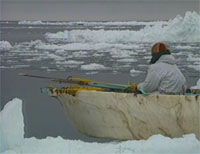
The Story of Nalukataq shows the preparation for and hunting of bowhead whales from the sea ice, and the springtime Nalukataq celebration of a successful whaling season. It was produced by the North Slope Borough in 1991. The original is DVD 0250 in the video archives of the Iñupiat History, Language, and Culture Commission (IHLC) in Utqiaġvik, Alaska (previously known as Barrow). To request this item, or any other item from IHLC's collections, please visit: http://www.north-slope.org/departments/inupiat-history-language-and-culture/resource-requests. (14:39 min.)

Video discussing the differences between first-year and multi-year sea ice near Utqiaġvik, Alaska (previously known as Barrow). Video produced by Frontier Scientists, WonderVisions, and the National Science Foundation, 2015. (8:24 min.)

Combining Geophysics and Traditonal Knowledge to Study Changing Sea Ice features Oliver Dammann, a PhD student at the Geophysical Institute, University of Alaska Fairbanks, discussing his research project that seeks a deeper understanding of sea ice through combining traditional knowledge with modern science by measuring the ice depth along whaling trails on the Chukchi Sea shorefast ice and working with Barrow whalers to learn how they understand the ice. Video produced by Molly Rettig for the Geophysical Institute, University of Alaska Fairbanks, 2013. (3:00 min)
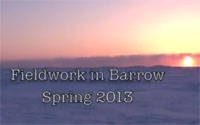
Video of sea ice research fieldwork being done in Utqiaġvik, Alaska (previously known as Barrow) in 2013 by Dyre "Oliver" Dammann. Matthew Druckenmiller, and Andy Mahoney of the University of Alaska Fairbanks. (4:42 min.)
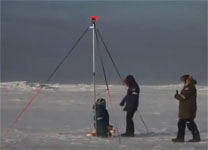
Video of sea ice research being conducted by the United States Navy during the 2013 field season on the shorefast ice near Utqiaġvik, Alaska (previously known as Barrow). Video produced by Nokinba Acker of the Barrow Arctic Science Consortium, March 3, 2013. (8:12 min.)

Video of sea ice research being done by the United States Naval Academy using a buoy (Ice Goat) designed to record sea level pressure, air and sea water temperature, and real time observations of the ice, Utqiaġvik, Alaska (previously known as Barrow), February 2012. Video produced by Nokinba Acker of the Barrow Arctic Science Consortium. (9:04 min.)
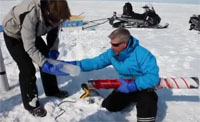
Video of sea ice research being done by Ken Golden, Professor of Mathematics, University of Utah, in the spring of 2012 on the shorefast ice near Utqiaġvik, Alaska (previously known as Barrow). Video produced by Nokinba Acker of the Barrow Arctic Science Consortium, September 19, 2012. (15:06 min.)

Video of thin sea ice showing why it is important to test the ice before you step on it. Video by Nokinba Acker of the Barrow Arctic Science Consortium, March 22, 2010. (31 sec.)
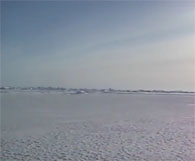
Video of driving on a snowmachine across an area of flat shorefast ice about five miles offshore from Utqiaġvik, Alaska (previously known as Barrow). The flat ice was about one mile wide and ten miles long. Video by Nokinba Acker, March 26, 2010. (54 sec.)
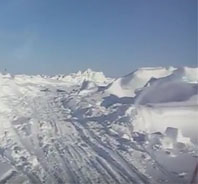
Video of driving on a snowmachine along a trail built by hand through rough sea ice. Video by Nokinba Acker of the Barrow Arctic Science Consortium, March 26, 2010. (22 sec.)
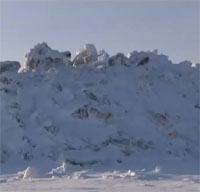
Video of a pressure ridge in the shorefast ice offshore from Utqiaġvik, Alaska (previously known as Barrow) on March 3, 2011. Video produced by Nokinba Acker of the Barrow Arctic Science Consortium, March 7, 2011. (2:11 min.)
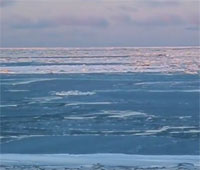
Video of early season sea ice moving along the shore at Utqiaġvik, Alaska (previously known as Barrow) on November 5, 2009. (55 sec.)
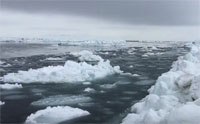
Video of the Chukchi Sea current pushing sea ice along the edge of the shorefast ice near Utqiaġvik, Alaska (previously known as Barrow), April 2016. Video by Arctic Wild. (1:07 min.)
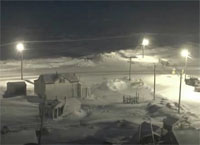
Webcam timelapse video of an ice shove that occurred at Utqiaġvik, Alaska (previously known as Barrow) on February 17-18, 2011 (one image every 5 minutes). This event resulted in 8m high piles of ice on the beach in some areas close to town. The images and video were produced by the Sea Ice Group at the Geophysical Institute, University of Alaska Fairbanks using data from the Barrow Sea Ice Observatory webcam mounted atop the 4-story bank building in downtown Barrow, Alaska, pointed north. For more information: http://seaice.alaska.edu/gi/observatories/barrow_webcam. (1:22 min.)

Video showing movement of sea ice and explaining how sea ice and its many moving forms affect climate and wildlife. Produced by the Alaska Satellite Facility, University of Alaska Fairbanks, September 2014. (4:24 min.)
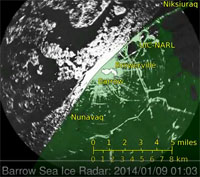
Video of animated radar imagery of sea ice movement at Utqiaġvik, Alaska (previously known as Barrow) from January 9-19, 2014. The images and animations were produced by the Sea Ice Group at the Geophysical Institute, University of Alaska Fairbanks using data from their 10 kW X-band marine radar mounted atop the 4-story bank building in downtown Barrow, Alaska, pointed north. Learn more about the radar project and view other animations at: http://seaice.alaska.edu/gi/observatories/barrow_radar. (5:58 min.)
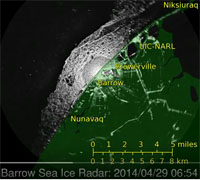
Video of animated radar imagery of large sea ice break-off event at Utqiaġvik, Alaska (previously known as Barrow) on April 29, 2014. The images and animations were produced by the Sea Ice Group at the Geophysical Institute, University of Alaska Fairbanks using data from their 10 kW X-band marine radar mounted atop the 4-story bank building in downtown Barrow, Alaska, pointed north. Learn more about the radar project and view other animations at: http://seaice.alaska.edu/gi/observatories/barrow_radar. (1:46 min.)
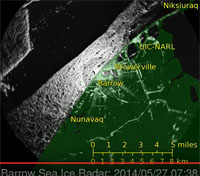
Video of animated radar imagery of 10-days of spring sea ice conditions at Utqiaġvik, Alaska (previously known as Barrow) from May 18-27, 2014. The images and animations were produced by the Sea Ice Group at the Geophysical Institute, University of Alaska Fairbanks using data from their 10 kW X-band marine radar mounted atop the 4-story bank building in downtown Barrow, Alaska, pointed north. Learn more about the radar project and view other animations at: http://seaice.alaska.edu/gi/observatories/barrow_radar. (5:55 min.)
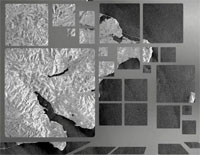
Video of animated synthetic aperature radar (SAR) imagery of sea ice in the Bering Strait from October 2007 to March 2008. Produced by the Alaska Satellite Facility, University of Alaska Fairbanks. (1:09 min.)
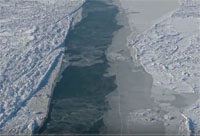
Video of ice cover over the Arctic Ocean in March 2017 taken during a helicopter flight from Utqiaġvik, Alaska (previously known as Barrow) to about 100 miles north. (10:43 min.)
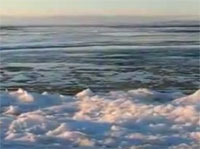
Video of fall ice formation in Kotzebue, Alaska on October 25, 2006. (19 sec.)
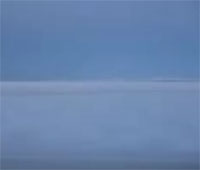
Video of frozen ice of Kotzebue Sound at Kotzebue, Alaska on November 9, 2006. (31 sec.)

Video of early fall ice formation in Kotzebue, Alaska on November 9, 2013. Historically, ice this thick would stay, but in more recent years it goes out to the ocean and new ice comes in and forms later. Video by Jimmy Evak. (53 sec.)

Video of fall ice conditons in Kotzebue, Alaska on November 16, 2013. Video by Jimmy Evak. (23 sec.)
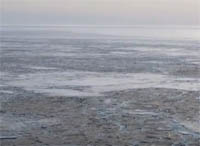
Video of spring break-up ice conditions in Kotzebue Sound as seen from high ground near Kotzebue, Alaska, May 2014. (22 sec.)

Video of the ice going out in Kotzebue, Alaska on May 24, 2009. (51 sec.)
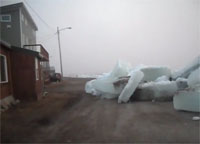
Video of ice piling up on Front Street (Shore Avenue) in Kotzebue, Alaska on May 30, 2011. The movement is caused by the ice being pushed out of Kotzebue Sound and water flowing in from rivers breaking up. (4:36 min.)
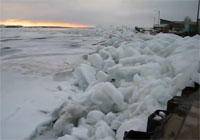
Video of large chunks of ice churning and moving past Kotzebue, Alaska in June 2011, Part 1 of 4. The movement is caused by the ice being pushed out of Kotzebue Sound and water flowing in from rivers breaking up. (40 sec.)
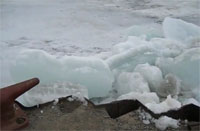
Video of large chunks of ice churning and moving past Kotzebue, Alaska in June 2011, Part 2 of 4. The movement is caused by the ice being pushed out of Kotzebue Sound and water flowing in from rivers breaking up. (48 sec.)
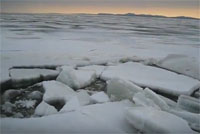
Video of large chunks of ice churning and moving past Kotzebue, Alaska in June 2011, Part 3 of 4. The movement is caused by the ice being pushed out of Kotzebue Sound and water flowing in from rivers breaking up. (51 sec.)
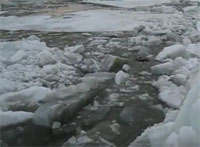
Video of large chunks of ice churning and moving past Kotzebue, Alaska in June 2011, Part 4 of 4. The movement is caused by the ice being pushed out of Kotzebue Sound and water flowing in from rivers breaking up. (16 sec.)
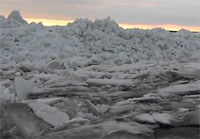
Video of large ice pile (ivu) in front of Kotzebue, Alaska, June 1, 2011. These piles were formed by the ice pushing out of Kotzebue Sound during spring breakup. (59 sec.)

Video of pans of ice moving during break up at Kotzebue, Alaska on June 9, 2011. The movement is caused by the ice being pushed out of Kotzebue Sound and water flowing in from rivers breaking up. Video by Max Blust. (1:40 min.)

Video of ice breaking up at Kotzebue, Alaska in June 2012. The movement is caused by the ice being pushed out of Kotzebue Sound and water flowing in from rivers breaking up. Video by Johnson Greene. (20 sec.)
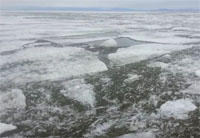
Video of Kobuk Lake ice breaking up and flowing past Kotzebue, Alaska in June 2014. People in Kotzebue call it "Kobuk Ice" because it is ice coming out from Kobuk Lake, Kobuk River and Selawik Lake. Before they had running water in the community, people looked forward to this event because they would collect and melt the ice and would get delicious tasting fresh water. Video by Jimmy Evak. (34 sec.)

Video of Kobuk Lake ice breaking up and flowing past Kotzebue, Alaska in May 2015. Historically, when the "Kobuk Ice" started moving it would run by Kotzebue for about two weeks. Video by Jimmy Evak. (37 sec.)
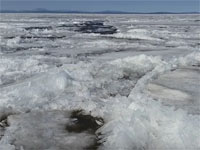
Video of Kobuk Lake ice breaking up and flowing past Kotzebue, Alaska on May 28, 2016, Part 1 of 2. Video by Jimmy Evak. (1:02 min.)
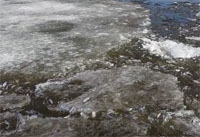
Video of Kobuk Lake ice breaking up and flowing past Kotzebue, Alaska on May 28, 2016, Part 2 of 2. Video by Jimmy Evak. (43 sec.)
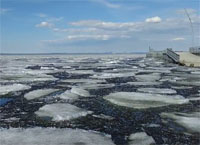
Video of Kobuk Lake ice breaking up and flowing past Kotzebue, Alaska in June 2017. Video by Jimmy Evak. (59 sec.)
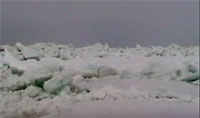
Video of moving pack ice in the Bering Strait at Wales, Alaska on May 10, 2007. Video by Paul Hamilton. (1:37 min.)
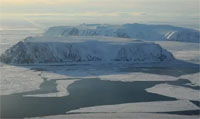
Video about sea ice in the Bering Sea. An audio slideshow with Alaska Dispatch reporter Jill Burke talking with Walt Meier, a sea ice research scientist with the National Snow and Ice Data Center (NSDIC) in Boulder, Colorado explaining scientific terminology and understandings of Bering Sea ice conditions. Published on April 1, 2010 by the Alaska Dispatch News. (3:19 min.)
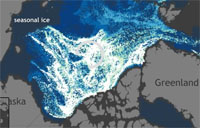
Video of animation of changing Arctic sea ice that tracks the relative amount of ice of different ages from 1990 through early November 2016. Decades ago, the majority of the Arctic's winter ice pack was made up of thick, perennial ice. Today, very old ice is extremely rare. In this animation, seasonal ice is darkest blue, and ice that is 9 or more years old is white. Video produced by the NOAA Climate.gov team in cooperation with climate and earth scientists from the National Oceanic and Atmospheric Administration and other agencies and institutions. (1:19 min.)
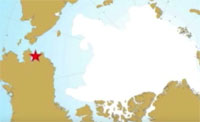
Video of Adam Freeburg, Ph.D student at the University of Washington, giving a presentation at the 6th Northern Research Forum Open Assembly in Hveragerði, Iceland titled Evaluating Prehistoric Sea Ice Variability and Culture Change in Northwest Alaska in September 2011. The presentation offers long-term perspective of sea ice variability and culture change in northwest Alaska based on researching tree rings, pollen, beach ridges, and archaeological fauna, such as ringed seal and bearded seal. His research also looks at lessons of adaptation and resiliency. (11:18 min.)
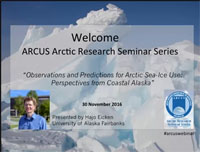
Video of Dr. Hajo Eicken, Director of the International Arctic Research Center (IARC) and Professor of Geophysics at the Geophysical Institute, University of Alaska Fairbanks, giving a presentation titled Observations and Predictions for Arctic Sea-Ice Use: Perspectives from Coastal Alaska to the ARCUS Arctic Research Seminar Series in Washington, D.C. on November 30, 2016. The presentation explores how the combination of surface-based observations, Indigenous and local knowledge, and remote sensing are particularly effective in addressing rapid changes in coastal ice environments. Specifically, it focuses on use of coastal landfast ice by Indigenous communities and industry to illustrate the importance of stakeholder guidance in defining the research problem and the types of observations and predictions needed. Video by the Arctic Research Consortium of the United States (ARCUS). (69:52 min.)

Home on the Ice: Sea Ice Change and Arctic Wildlife. A presentation by Olivia Lee, Research Assistant Professor at the International Arctic Research Center (IARC), University of Alaska Fairbanks, given in Fairbanks, Alaska on February 16, 2016 as part of the Science for Alaska Lecture Series sponsored by the Geophysical Institute at the University of Alaska Fairbanks. (38:36 min.)

